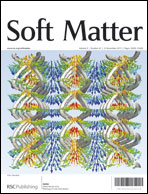Synthesis and characterization of graft copolymers able to form polymersomes and worm-like aggregates†
Abstract
Poly(glycerol adipate)-graft-(poly(ε-caprolactone)-block-poly(ethylene oxide)) (PGA-g-(PCL-b-PEO)) is synthesized by ring opening polymerization of ε-caprolactone initiated by the hydroxyl groups of PGA. This is followed by grafting of poly(ethylene oxide) monomethylether mPEO-N3 onto the PCL blocks using copper-catalyzed azide–alkyne cycloaddition (CuAAC, “click” reaction). All polymers form micelles of radii in the range of 10 nm after dissolving in acetone and dialysis against water. Micelles formed by PGA-g-(PCL-b-PEO) show smaller critical micelle concentration (cmc) and higher stability against temperature increase compared to micelles formed by PCL-b-PEO with an identical chemical composition to the grafted segments. Additionally, PGA17-g-(PCL24-b-PEO44) forms worm-like aggregates prepared by the cosolvent/evaporation method. The resulting worm-like aggregates are visualized by transmission electron and confocal laser scanning microscopy and show shape persistent behaviour over their entire contour length. It is suggested that these worm-like aggregates are formed by partially fused polymersomes under the influence of shear flow. They have the potential for simultaneous delivery of hydrophobic and hydrophilic drugs.


 Please wait while we load your content...
Please wait while we load your content...